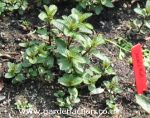Given half a chance, mint will take over your whole garden. That natural vigor makes this hardy perennial a great, no-fail plant for beginning gardeners - or for anyone who needs a tough, fast-growing and lovely ground cover.
Instructions
things you'll need:
- Garden Trowels
- Mint Plants
- Planting Containers
- Potting Soil
- Clay Drainage Tiles
- 1
- 2Buy mint plants at the nursery for planting in early spring, as soon as the ground can be worked. (Mint does not grow well from seed.)
- 3
- 4Set plants 12 to 18 inches apart, depending on the variety. To control their rampant ways, plant them in bottomless containers sunk into the soil. Clay drainage tiles, about 10 inches deep and 6 to 8 inches across, are ideal.
- 5
- 6
- 7Harvest sprigs as you need them throughout the growing season.
Growing Area
- The area in which a mint plant grows inside plays a major role in its health. Plants grown without access to natural light or a comparable artificial grow lamp may produce brown, unhealthy mint leaves and be more susceptible to pest and disease problems. Keep the mint plant where it receives an adequate amount of light during the day to keep it healthy and green; mints grow best in full light or partial shade.
Pests
- Pest problems can lead to the formation of dead spots on the leaves of a mint plant that become brown or black as the mint plant is weakened. Scale insects, aphids and spider mites are pests that affect indoor houseplants and feed on the leaves, which stops the mint from producing nutrients properly. Apply a mild pesticide or insecticidal soap to the mint plant according to the directions to keep the mint plant healthy.
Anthracnose
- Anthracnose is a fungal disease that can affect mint plants. It causes small black or swollen spots to appear on the leaves of the mint plant, and the leaves will eventually die if the plant remains untreated. Prune healthy plants in the fall to prevent the disease from spreading and using the plant as a winter host, and remove affected leaves from sick plants to stop the anthracnose from producing spores. Keep the mint's planter drained.
Mint Rust
- Mint rust is a disease that affects mint plants by creating reddish brown spots on the underside of the leaves and infecting the stems of the plant. Eventually, the mint plant will experience leaf loss as the fungus produces spores and kills off the leaves. Apply fungicides that contain the chemical chlorothalonil to the mint plants to kill the fungal spores and stop the disease from spreading; follow all directions on the fungicide for the best results.
Uses for Mint
 For a healthy way, Mint, especiallyPeppermint has been known to cure problems such as Nausea, indigestion and even heartburn.
For a healthy way, Mint, especiallyPeppermint has been known to cure problems such as Nausea, indigestion and even heartburn. Apple Mint is used for juices and ice tea. Also you can create the famous alcoholic cocktail, Mojito's with crushed Mint.
Apple Mint is used for juices and ice tea. Also you can create the famous alcoholic cocktail, Mojito's with crushed Mint. Ginger Mint is delicious with salads.
Ginger Mint is delicious with salads. Pineapple Mint helps along a cheese and cracker plate.
Pineapple Mint helps along a cheese and cracker plate.Propagation
Mint is sold at most garden centres in small pots - as long as they are purchased after all danger of frost has passed, they can be planted straight outside.
Mint is sold at most garden centres in small pots - as long as they are purchased after all danger of frost has passed, they can be planted straight outside.
Mint has shallow, creeping roots which can be broken off and placed either directly in the ground or in pots containing potting compost. Because mint is such a strong-growing plant, it can easily kill nearby plants. The solution when planting outside is to sink a bottomless container, such as an old bucket, in the ground and plant the mint in this area. The roots might not be stopped 100%, but it will do the job. Another alternative is to dig a hole to a depth of 30cm (1ft) and line it with black plastic (pierced with small holes for drainage). The soil is then replaced in the black plastic and the mint planted in that area.
Mint suffers from only one disease and that is rust - allow it to get a hold and it will kill all your mint plants. There are chemical sprays for rust, but they can often be only a part solution. The best method is to examine each plant carefully for signs of rust (orange blobs generally on the underside of the leaves) and remove any leaves affected - spray as well with a chemical if you want. If this does not remove the infection chop the plant down to ground level and burn it all - drastic, but the only cure in the late stages of rust infection.
Recommended Mint Varieties
Spearmint Mentha spicata - a traditional mint for mint sauces. A strong grower with attractive dark green leaves.
Alpine Mint Bush Prostanthera cuneata - try something different, mint leaves with pure white flowers, a herb with true beauty.
Chocolate Mint - really does taste a bit like mint chocolate!. A novelty worth a try?






No comments:
Post a Comment